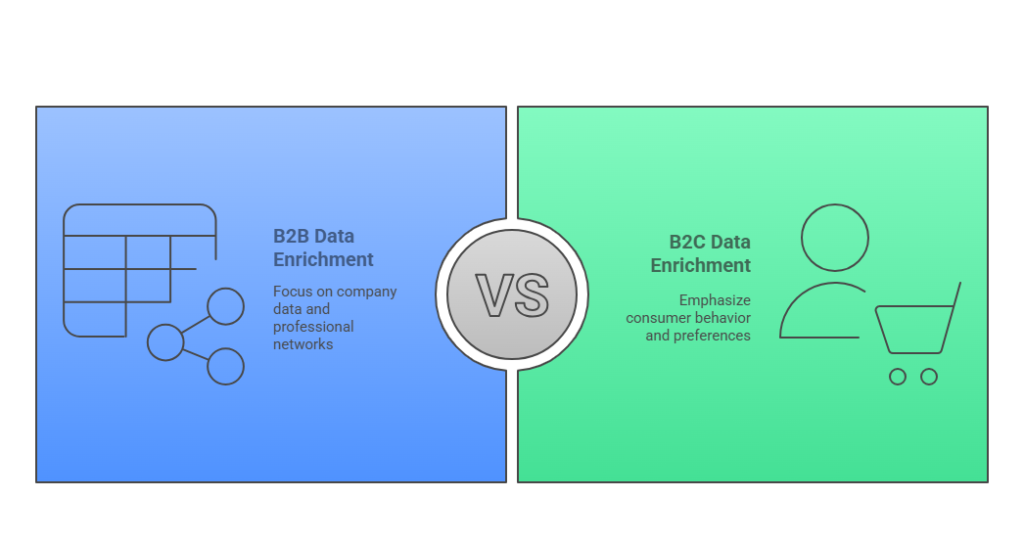
In today’s data-driven world, knowing your audience is no longer optional — it’s essential.
That’s where data enrichment comes in. It transforms incomplete or outdated information into meaningful insights that drive conversions.
But not all enrichment is the same.
B2B data enrichment focuses on companies and professionals, while B2C data enrichment revolves around consumers and behaviors.
Let’s break down the key differences, tools, and best practices so you can choose the right approach for your business.
What Is Data Enrichment?
Data enrichment is the process of enhancing your existing customer or lead data with verified, external information.
It’s how you turn a simple name or email into a rich customer profile that helps marketing, sales, and automation work smarter.
Example:
- For B2B, you might enrich an email with company size, industry, or job title.
- For B2C, you might add demographics, shopping habits, or location.
Enrichment ensures accuracy and depth in your CRM, enabling smarter campaigns and higher ROI.
Related reads:
B2B Data Enrichment: Adding Business Context
B2B enrichment focuses on organizations and the decision-makers within them.
It’s used by SaaS platforms, agencies, and enterprise marketers who rely on firmographic data to personalize outreach.
Typical Data Points:
- Company name, domain, revenue, and industry
- Job title, seniority, and contact details
- Employee count and location
- Tech stack and funding history
- LinkedIn profiles and corporate emails
Common sources include LinkedIn, Crunchbase, Apollo.io, and ZoomInfo.
It’s essential for account-based marketing, sales prospecting, and B2B lead generation audits — where accurate data drives smarter targeting and faster deal cycles.
B2C Data Enrichment: Personalizing Consumer Experiences
In the B2C world, enrichment focuses on individual consumers — their lifestyle, preferences, and intent.
Retailers, eCommerce brands, and D2C marketers use this data to improve personalization and retention.
Typical Data Points:
- Name, age, gender, and income
- Purchase behavior and browsing patterns
- Product preferences and categories
- Location and device type
It’s powered by online stores, loyalty programs, mobile apps, and social media insights.
For example, an eCommerce brand may use E-Commerce Data to build accurate audience segments and send targeted offers based on buying behavior.
B2B vs B2C Data Enrichment: Key Comparison
| Factor | B2B Data Enrichment | B2C Data Enrichment |
|---|---|---|
| Focus | Businesses & decision-makers | Individual consumers |
| Data Type | Firmographic & professional | Demographic & behavioral |
| Goal | Lead quality & segmentation | Personalization & retention |
| Sources | LinkedIn, Crunchbase, Apollo | Social media, eCommerce, apps |
| Compliance Risk | Moderate | High (personal data) |
While both aim to enhance targeting accuracy, their data sources, privacy rules, and applications differ significantly.
Best Practices for Effective Data Enrichment
A powerful enrichment process isn’t about collecting “more” data — it’s about collecting the right data.
Proven Best Practices:
- Start with clean data – Run a quick data cleansing process before enrichment.
- Define clear attributes – Only enrich fields that impact segmentation or personalization.
- Use verified sources – Always choose reputable vendors or verified databases.
- Automate enrichment – Connect enrichment APIs to your CRM for real-time updates.
- Refresh quarterly – Re-enrich your database to remove stale or outdated records.
- Track ROI – Use tools like our B2B Lead Generation ROI Calculator to measure results.
Following these steps ensures better accuracy and long-term data health.
Popular Tools and Platforms for Data Enrichment
There are dozens of enrichment tools out there, but each specializes in different needs.
Here’s a quick comparison to help you choose wisely:
| Use Case | Recommended Tools | Key Strength |
|---|---|---|
| B2B Enrichment | Clearbit, Apollo, ZoomInfo | Rich firmographics & decision-maker data |
| B2C Enrichment | Klaviyo, Segment, FullContact | Behavioral & purchase insights |
| Hybrid / SaaS | Clearbit + HubSpot | Combines lead scoring & personalization |
For larger databases or API-based enrichment, our B2B Data Services offer verified, up-to-date company and contact information ready for integration.
Privacy, Ethics, and Compliance in Data Enrichment
Modern enrichment goes hand-in-hand with data privacy.
With regulations like GDPR and CCPA, businesses must handle consumer and corporate data transparently.
Key Compliance Principles:
- Always use opt-in data for B2C contacts.
- Provide an easy opt-out or data removal request.
- Avoid scraping or unverified datasets.
- Audit vendors for compliance certifications.
- Store data securely with clear retention policies.
If you handle sensitive consumer data, prioritize GDPR-compliant solutions such as LFBBd’s E-Commerce Data platform, which ensures both accuracy and ethical sourcing.
Future Outlook: AI and Predictive Data Enrichment
The next generation of data enrichment is AI-driven and predictive.
Instead of waiting for users to fill out forms, AI models now infer missing attributes or intent signals in real time.
What’s Emerging:
- Predictive modeling: AI infers missing firmographics or demographics.
- Behavioral intent detection: Tracks readiness to buy through engagement.
- Real-time API enrichment: Instantly updates CRM data on form submission.
- AI scoring: Assigns lead scores based on likelihood to convert.
If your brand relies on automation and AI, you’ll benefit from combining enrichment with advanced SaaS Database intelligence for faster, smarter targeting.
